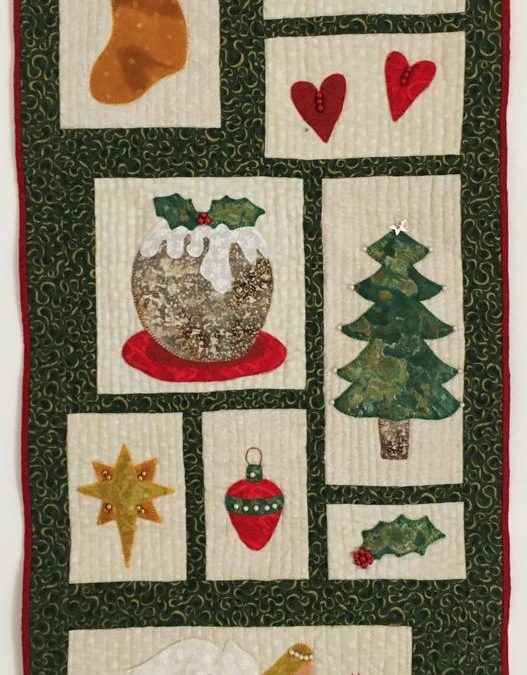
SYMBOLS OF CHRISTMAS
So, I was hanging up my Christmas Quilts for Advent and came across this one which I made in 2018 – it was to take part in a Guild Challenge. Tollgate Quilters Guild celebrated its 30th Anniversary (Pearl) and we were all given a small packet of Pearls to include on a small quilt. If you look closely, you will find the Pearls decorating some of the blocks. I have also included a photo of the “Garden” that was by Mitchell Park to celebrate our 30th Anniversary in 2018. Taking another look at it got me started on the search about the Symbols of Christmas.
All the information below was gleaned from multiple sources on “Aunty Goggle”.
HANGING CHRISTMAS STOCKINGS
Stockings hanging along the fireplace mantle is arguably one of the most recognizable symbols of Christmas.
The Christmas Stocking tradition dates back to at least the 1700s. It even appears in the famous 1822 poem, “A Visit from Saint Nicholas”, also known as “Twas the Night before Christmas.”
The legend behind why we hang stockings on the fireplace to be filled with goodies is believed to be the origin story of Santa Claus. Back in the 4th century, somewhere around what is modern-day Turkey, there was a poor widower who couldn’t afford a dowry for his three daughters and thought of selling them into servitude. A local bishop, St. Nicholas, was known for his charity, but the father refused to accept any gifts from the monk. As the legend goes, one night, Nicholas secretly tossed bags of gold into the man’s house, and the pouches landed in the stockings that were hanging to dry over the fireplace!
GIVING CHRISTMAS GIFTS
Gift giving was a customary tradition during the Winter Solstice, things like natural ornaments, or gifts from nature were given as a means of giving thanks for the year that had passed and spreading good cheer and positive anticipation for the year that was to come. It is a symbol of gratitude and kinship.
Christmas gift giving is yet another continuation of pagan traditions, in particular the Roman festival of Saturnalia.
Saturnalia began on December 17 and culminated a week later on December 24.
During this celebration (which included a feast, drinking, gambling, and other makings of merry), presents such as pottery, fruit, nuts, and candles were exchanged.
Though early Christians wanted to completely do away with the pagan traditions, church leaders feared a significant backlash in the case of Saturnalia.
So instead we got Christmas gifts– an homage to the three Wise Men bringing the baby Jesus gold, frankincense, and myrrh.
Since then, Christmas presents have transformed into the fulcrum of the festivity. Of course, these days the custom centres around children, with long lists of Christmas gift ideas sent to Santa so his elves will have time to make the toys.
HEARTS
It’s possible that the Greek association of ivy (the leaf shape looks a bit like a heart) with the god Dionysus (the god of sensual things) led to the heart being identified with romantic love. Once the heart surfaced as a mark for sex, it’s not a large leap to understand how it came to connote love, too. And, in time, eternal love.
It was around the Middle Ages that the heart symbol took on its current meaning. At that time, according to Christian theology, it was meant to represent Jesus Christ and his love. Devout Christians began to inject the icon into art and literature from that era.
FIGGY PUDDING
It’s mentioned in A Christmas Carol and in actual carols. Why do we sing about this Dickens of a dessert?
People sing about it in “We Wish You a Merry Christmas.” Charles Dickens wrote about it in A Christmas Carol.
What Is Figgy Pudding?
In its most basic form, Figgy pudding is a steamed, domed-shaped cake baked in a water bath in the oven. It’s made with alcohol and dried fruit and is a traditional English dessert. It’s more like a cake than a soft, custard-like pudding.
Figgy pudding is also known as Christmas pudding or plum pudding. It can also be affectionately called “pud.”
What Is Figgy Pudding Made Of?
The flavours can include figs, plums, raisins, currants, oranges, cherries, cranberries, citrus zest and juice, along with notes of cinnamon, nutmeg, cloves, ginger and allspice. The result is a dessert similar to what we know as a holiday fruitcake.
Why Is It Called Figgy Pudding?
The ‘pudding’ part of the name makes it a dessert in Britain. At some point the dish included figs, lending itself to the term of ‘Figgy’ as part of a Christmas pudding recipe.
Why Do People Sing About Figgy Pudding?
For starters, it’s a symbolic Christmas dessert. It was originally made with 13 ingredients which represented Christ and the 12 apostles. It was finished with a sprig of holly on top as a symbol of the crown of thorns.
Near the end of the 16th century, carollers began to sing the English folk song, “We Wish You a Merry Christmas.” When poor folks stood on the doorsteps of the wealthy and sang, “Oh bring us some Figgy pudding,” and “we won’t go until we get some,” they probably were having a bit of fun, requesting a helping of this rich Christmas dessert.
EVERGREEN CHRISTMAS TREES
Yule Tree – An Important Pagan Symbol
The Yule Tree was also another important symbol in pagan tradition. Originally, it represented the Tree of Life or the World Tree among early pagans. In ancient times it was decorated with gifts people wanted to receive from the gods. It was adorned with natural ornaments such as pinecones, berries and other fruit, as well as symbols sacred to the gods and goddess. In some holiday traditions, garlands of popcorn and berries were strung around the tree so that visiting birds could feed off the tree as well.
Evergreens for Yule – Symbols of Renewal
Evergreens were cut and brought indoors to symbolize life, rebirth and renewal. They were thought to have power over death because their green never faded, and they were used to defeat winter demons and hold back death and destruction. Because of their strength and tenacity, they were also believed to encourage the Sun’s return.
The history of Christmas trees started long before Christmas became the most important Christian holiday.
Evergreen plants have long held symbolic significance during the wintertime. Among the ancient Egyptians, Celts, Druids, Romans, and Vikings, they were believed to keep evil and illness away.
Germany is credited with the first legit real Christmas tree, with a tradition that kicked off in the 16th century.
This was when the triangular shape became a common thing, which added more Christmas tree meaning.
Now, the three corners of the triangle represented the Holy Trinity of Christianity- the Father, the Son, and the Holy Ghost.
STAR TREE TOPPER
One of the holiday’s more religious symbols, the Christmas Star represents the bright star that shone brightly over the town of Bethlehem on the night that Jesus Christ was born. According to the Nativity Story—sometimes called The Christmas Story—in the Gospel of Matthew, the Star of Bethlehem guided the three kings (also known as the wise men or magi) to find baby Jesus in a stable. The Christmas Star has also come to represent hope and peace.
The Christmas tree star topper comes from similar origins as the Christmas tree angel.
According to the Bible, a star rose with the birth of Christ. It helped to guide people to his birthplace in Bethlehem so that they could worship him.
So, we put a star atop the Christmas tree to pay homage to the guiding light on that night.
CHRISTMAS ORNAMENTS
As mentioned before, the use of evergreen trees to observe Winter holidays dates back long before Christmas was created. But the Christmas ornaments we use to decorate them are a mere 500 years old!
In the 16th century, Germans began decorating their trees with real apples, candles, nuts, and berries.
At that time, these trees were known as “paradise trees” (perhaps a reference to the Garden of Eden?).
The puritanical early Americans were initially less inclined to adopt the Christmas tradition. That is until a depiction of Queen Victoria (who was married to German Prince Albert) included a decorated Christmas tree.
RED AND GREEN CHRISTMAS COLORS
When you think of Christmas colours, red and green immediately come to mind. And while nobody knows for certain how they became the unofficial colours of Christmas, there are a few theories…
Many Christians see the colours as being inspired by the life of Jesus, with green representing the everlasting life of Christ (much like evergreen trees, which stay green all winter long) and red representing the blood shed during his crucifixion.
Historians argue that the colours originated during the ancient celebration of Saturnalia, where Romans would hang boughs of Holly in their homes. The tradition of hanging red and green holly evolved into hanging other red and green decorations.
But what really solidified red and green as Christmas colours was actually Coca-Cola!
In 1931, they created magazine ads that featured Santa dressed in red (the brand’s trademark colour) surrounded by a green border and writing.
The ads became so popular that they defined the American image of Santa, and red and green were solidified as the colours of Christmas in most people’s minds.
HOLLY
It is a symbol of hope, protection and luck.
During the festival of Saturn, holly boughs were given as gifts, meant to bring the recipient both good luck and protection from dark spirits. In the Celtic tradition, at the time of Winter Solstice the Oak King was defeated by the Holly King (a monstrous intimidating man covered in holly leaves and brandishing a bat made of holly), who was then given rulership until the Summer Solstice (when the Oak King, and his partner the Mother Goddess would again take over).
Later on, as Christianity became more prevalent, some viewed this solstice symbol as being representative of the crown of thorns that Jesus wore, the red berries representing the blood that was shed on his brow. This plant is said to represent the masculine element.
With its shiny dark green leaves and bright red berries, holly is another evergreen shrub that is synonymous with Christmas.
ANGEL
With Christmas being primarily known as a Christian holiday, it’s no wonder that one of the most recognized Christmas tree decorations is the Christmas angel tree topper.
The angel represents the role of angels in the birth of Jesus. As recounted in the most famous Bible story of all, angels appeared in the sky over Bethlehem to announce the saviour’s birth.
There is a good reason why angels, like stars, are traditional Christmas tree toppers, and that is because these messengers of God played prominent roles in the Nativity of Jesus. Archangel Gabriel appeared to the Virgin Mary, delivering the message from God that she would bear His son. Another angel visited Joseph in a dream to inform the carpenter that he should place his trust in Mary. And later in the Christmas Story, three angels appeared in the sky over Bethlehem to announce the birth of the Christ child.

